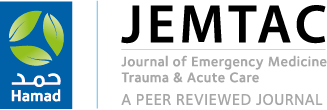-
oa Comparing the predictive value of MSI, SI, ASI, and qSOFA with acid–base markers for septic shock morbidity and mortality
- Source: Journal of Emergency Medicine, Trauma and Acute Care, Volume 2024, Issue 7, ديسمبر ٢٠٢٤, 28
-
- ٢٧ فبراير ٢٠٢٤
- ٠٢ يونيو ٢٠٢٤
- ٢٨ أكتوبر ٢٠٢٤
ملخص
Background: Septic shock remains a critical medical condition with significant morbidity and mortality rates worldwide. Early and accurate risk assessment is crucial for optimizing patient management and improving outcomes. Various clinical indices and biochemical markers have been proposed as predictive tools for assessing the severity of septic shock and its associated morbidity and mortality. The aim of the study was to compare the predictive validity of the MSI (modified shock index), SI (shock index), ASI (age shock index), and qSOFA (quick sequential organ failure assessment) score with metabolic acidosis, anion gap, base deficit, and lactate levels in the assessment of morbidity and mortality outcomes in adult patients diagnosed with septic shock.
Methods: A prospective observational study was conducted in a tertiary care hospital. This study included 264 patients who were diagnosed with sepsis. Ethical approval was obtained from the institutional ethical committee. A data collection sheet was used for collecting data, including both clinical and metabolic parameters. Receiver operating characteristic analysis was performed using coGuide REAP.
Results: The median age of participants was 60 years (IQR (interquantile range): 45–70 years). The predictive validity of metabolic parameters was higher in predicting “mortality” as indicated by the area under the curve (AUC) values (lactate: 0.816, base deficit: 0.816) compared with clinical parameters (ASI: 077, SI: 0.709). The predictive validity of clinical parameters was higher in predicting “morbidity” as indicated by AUC values (ASI: 0.761, MSI: 0.698) compared with metabolic parameters (base deficit: 0.728, anion gap: 0.611).
Conclusions: Predictive validity was higher for clinical parameters related to morbidity and higher for metabolic parameters related to mortality.



